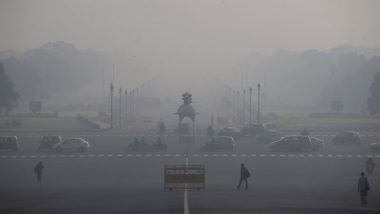Washington, October 18: People with a disease characterised by lung scarring are at a higher mortality risk if they live in areas with increased levels of air pollution from industrial sources and vehicular traffic, according to a study. The research, published in the journal JAMA Internal Medicine, is the first to link the chemical composition of fine particulate air pollution to worsened fibrotic interstitial lung disease (fILD) outcomes. It is also the largest study ever done to evaluate the impact of air pollution on these patients, the researchers said.
"Some people with these lung diseases have an expected lifespan from diagnosis to death of only a few years, and yet it's a mystery as to why they developed the disease, why their lungs become so scarred," said lead author Gillian Goobie, doctoral candidate at the University of Pittsburgh, US. Air Pollution: People With Long COVID-19 Need Extra Precaution in Polluted Air, Says Study.
"Our study points to air pollution -- specifically pollutants from factories and vehicles -- as potentially driving faster disease progression and premature death in these patients," Goobie said.
The researchers obtained data from 6,683 patients with fILDs in the US and Canada and linked their home addresses with satellite and ground-monitoring air pollution data to determine air pollutant composition to an accuracy of less than half a mile.
They specifically looked at a pollutant known as PM2.5, which refers to particulate matter that measures less than 2.5 microns across, a size invisible to the naked eye.
This type of pollution is so small that it can infiltrate deep into the lungs and even cross into the blood stream, where it can contribute to other diseases outside of the lungs, such as heart disease.
"In the past, most environmental health research has focused on the simple definition of PM2.5 as anything of that size. But PM2.5 is chemically diverse, with a different composition depending on whether it came from a forest fire or a tailpipe," said study co-author James Fabisiak, associate professor in Pitt Public Health.
"Research has lacked in determining if the type of PM2.5 matters when it comes to health effects. Our new research is a big step towards filling in that knowledge gap," Fabisiak said. Delhi Air Pollution: Air Quality Turns ‘Poor’ in National Capital, CAQM Asks States To Strictly Enforce Pollution Control Measures.
According to the team's calculations, if exposure to industrial pollutants had not occurred, most premature deaths among participants living in areas of North America with a heavier burden of industry could have been avoided.
Participants of colour were disproportionately exposed to higher levels of man-made air pollutants: 13 per cent of the high-exposure group were non-white, but only 8 per cent of the low-exposure group, highlighting the impact of environmental injustice in these findings as well, they added.













 Quickly
Quickly




















